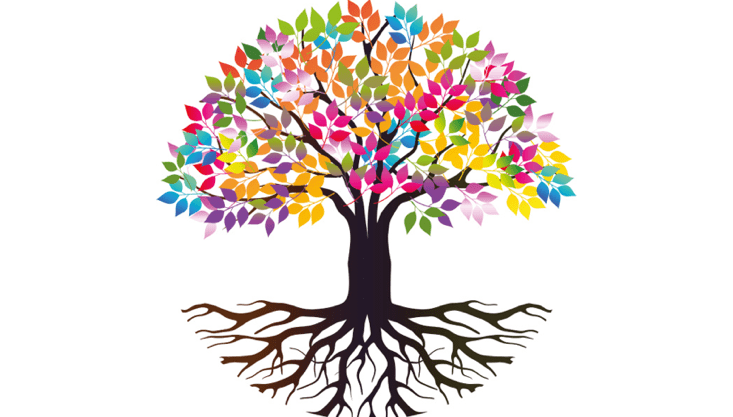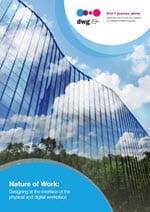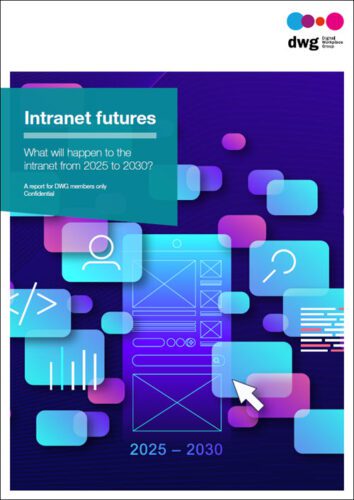Nurturing cultures of inclusivity and belonging with the digital workplace

Top of the list of Paul Miller’s digital workplace predictions for 2020 sits: “‘Accessibility’ rises in importance as part of a new ‘inclusive workplace’ focus”. This prediction – and aspiration – is aligned with how Paul sees 2020 kicking off what he’s termed the “Decade of Courage”. Here, he calls for all of us who have the capacity to do so to step forward and make a difference in our own worlds and with those we connect with moment by moment. Historically, accessibility has often been minimized as a priority or tacked on as an afterthought, something we at DWG see time and again through our benchmarking. As Martin White has written: “Accessibility is rarely on the agenda. The assumption appears to be that all employees are without disabilities.” Going forward, we as an industry have the opportunity to change this.
It therefore felt an important moment to focus our last Digital Nations Group Hangout of 2019 on what practitioners and experts can be doing to create more accessible and inclusive digital workplaces.
We were delighted to be joined by Kim Clark, a speaker, trainer, workshop leader and consultant specializing in diversity, inclusion and belonging communications, as our guest. We were also pleased to welcome a mix of DWG members and non-members who dialled in to help us share, listen and learn from each other. Here are some of the highlights from our conversation, one which we’re looking forward to diving deeper into as 2020 (and the 2020s) unfold.
A sense of “belonging”, where you’re “seen, heard and valued”
Accessibility, and increasingly diversity and inclusion, are familiar routes into creating work environments that are welcoming – and usable – to the full spectrum of abilities, genders, ethnicities, personalities, ages and more, which make up the tapestry of the human race, with the aim of helping all to flourish as their full selves.
During the Hangout, Kim introduced two key additions to our lexicon, both of which help to capture the underlying impacts behind much of this work.
The first was that we should be looking to nurture cultures of “belonging”, a concept developed by Pat Wadors during her time at LinkedIn. As Pat has written: “What I really wanted was those moments when I feel that I belong to a team, I matter, and I’m able to be my authentic self. I don’t want to be seen as a number, a gender, or an ethnic box.” No one wants to feel like a “token” representative of a single community; they want their full self to be appreciated in all its richness.
The second was making sure that people – and in particular marginalized groups – feel “seen, heard and valued”. This phrase is taken from Dr Brené Brown, who has described the heart of connection between people as: “the energy that is created between people when they feel seen, heard and valued — when they can give and receive without judgment”.
And so, at the root of our accessible, inclusive, diverse workplaces, there is fundamentally a culture where people feel they belong, and in which they’re seen, heard and valued.
The digital divide in work
While this area has historically been the remit of HR – or indeed of Facilities and IT when it comes to accessibility – there are two key roles that digital workplace practitioners can play in nurturing this sense of belonging.
The first is by making our platforms accessible through how they’re designed and delivered.
The second is by making them inclusive, through amplifying cultures of belonging in the stories and content published on them.
A useful first step in both processes is to identify who we are unintentionally excluding and failing to “see” within our user bases.
The “digital divide” is a gap spoken about in the public realm, which refers to the fact that there are large swathes of populations who are excluded from accessing and using modern technologies. The reasons for this are many and varied, ranging from lack of connectivity and rich/poor divides to ability and much more.
Within the digital workplace, we often talk about inequalities in who has access to our platforms, whether that be frontline vs headquarters, contractor vs employed, local offices, those with different abilities, and much more. However, different terms are often used as a way of expressing those gaps: “accessibility” is one, “local/global balance” another.
For practitioners, it may help to transpose the idea of the digital divide from the public realm into our workplace as a way in to identifying the “haves” and “have nots” for our services. What exactly is the digital divide for different groups of people within your organization and why does that divide exist? Is it because they need better support in developing their digital literacy? Is the content inaccessible or irrelevant to them? Does the technology itself exclude them? Every organization will likely have its own digital divide, which is impacting its culture of inclusivity and belonging.
What are your unconscious biases?
Even if, and when, we’ve identified the digital divides that exist in our respective organizations, we can still be unintentionally exclusionary in our digital workplace activities. To counter this, Kim shared that we need to: “get real with our own unconscious biases; there’s going to be things we don’t see, because we don’t know what we don’t know”.
Even if we have the conscious intention to be inclusive, research has suggested that our tendency to instinctively categorize as a cognitive shorthand means that we’re still subconsciously likely to harbour quickfire assumptions about certain groups. Within the digital workplace, this may manifest in the language we use when producing content, in the images we select, in who we think our users are. We may unintentionally choose gendered language, or language that reinforces certain power dynamics, or language that is HQ-centric, or ableist, for example.
And there are steps we can take to address this area, such as: starting to get a better understanding of those unconscious assumptions we’re making; understanding and addressing our fears of saying the wrong thing (such as explored by Vernā Myers in her book); and starting to make even the small changes that can have a big difference (such as using “partner” instead of “husband” or “wife”). It’s ultimately about becoming “conscious communicators”. For example, I’ve lost count of the number of times I’ve been referred to as “he” in emails, because an assumption has been made based on my name that could easily have been avoided by using “they”!
Nurturing psychological safety
The concept of “psychological safety” isn’t new, having first emerged in the 1960s and then again in the 1990s, and much has been written on how psychological safety is a pre-requisite for high-performing teams. But, more recently, the term has started to be used within the context of diversity, inclusion and belonging, and is an area touched upon during our DNG Hangout.
Psychological safety is ultimately: “the belief that one will not be rejected or humiliated in a particular setting or role”. For those from marginalized groups, this can mean the difference between feeling they can openly share their needs, innovative ideas, and bring their full selves to work, or on the other hand feeling the need to hide or minimize who they really are. It’s about cultivating that “safe space” in which people feel they will be “seen, heard and valued”.
As digital workplace practitioners, we can play a role in creating an environment of psychological safety like this, in which people can share their needs and ideas with us. We can do this through the stories we tell and in how we work with different groups of people in our user research and design work. And we can also do it by showing people they can give us honest feedback, as well as by listening, understanding and seeking to foster empathy.
Creating the accessible and inclusive digital workplace
And so, how can we not only help to create more accessible digital workplaces through our technology and content, but also nurture these cultures of inclusivity and belonging?
For the first, ultimately, accessibility must not be viewed just as a box-ticking compliance task. As Inovtra has written of its own experience:
“… we thought we were doing pretty well with our accessibility compliance until one of our customers asked us to politely reconsider.
They asked us to actually sit with users to observe how they use our intranet software. We ran a number of focus groups, meeting with users with a range of disabilities to understand what their day-to-day challenges are.
We were amazed, and not in a good way. We learned just how difficult it was to use our intranet software, despite being technically ‘compliant’.
We tried it out for ourselves. We challenged ourselves to use our intranet whilst having our monitor turned off. We learned how screen readers work and how to use them and the shortcuts they provide. We also tried using the site without a mouse.
When we went through this exercise, we had an epiphany. We realised that we were not serving all of our users with a great experience and we needed to do better. Consequently, we changed the attitude of everyone working in Invotra to recognise the challenge of delivering an intranet for all users.”
Others have had similar revelations about their digital workplace platforms, such as that the design trend to have lots of white space on the page makes it incredibly hard for those who suffer from migraines or who have dyslexia. The quick fix of giving a choice of background colour can therefore have a big impact.
One of the big challenges here is a lack of accessibility-trained researchers, designers, developers and content publishers, who deeply understand how to research, design and deliver accessible experiences for those who have a range of motor, vision, hearing and neurological needs, as well as for a diverse workforce in terms of location, language, learning preferences, gender, ethnicity, and more. We must be intentional in hiring contractors and/or employees with disabilities who know first-hand of the UX design challenges.
Accenture has previously written on the need to develop “inclusive developer ecosystems”, aimed at improving three areas: involving people with disabilities throughout the project; engaging accessibility professionals; and promoting developers trained in designing for accessibility. DWG has also previously written about five intranet accessibility myths and how to address them.
Additional useful resources include:
- Web Content Accessibility Guidelinesfrom the Web Accessibility Initiative
- Microsoft’s own principles, Inclusive Design toolkitsand specific guidance on Office 365
- an example of how Barclays has created “Diverse Personas”to help those designing services to better understand the needs of customers with disabilities.
And how can we better use the digital workplace to help amplify a culture of inclusivity and belonging? Kim shared a number of areas on which we as digital workplace and internal communications professionals can focus, such as:
- Making sure the stories being told through internal communications are sourced and told globallyand not just from the bricks and mortar HQ; make your digital workplace truly your global HQ.
- Using images of the people actually working for you, rather than stock images.
- Avoiding tokenism, where you make your workforce seem more diverse than it actually is.
- Considering “small” wins that can have a big impact, like providing preferred pronouns and phonetic spellings/audio recordings of people’s names on their profiles (for the record, mine would be she/her, and “Shimrit” is actually pronounced “shimreet”).
- Using closed captioning on your videos; this will help not only those who are hearing impaired but also those in environments where they’re not able to have the sound on.
As Kim shared for her final thoughts: “Diversity, Inclusion and Belonging (DIBs) is serious and we must be intentional about it, becoming conscious communicators. Only then will we see meaningful difference made. DIBs isn’t a “programme” to many folks; it’s their life, their identity, and we have to take that seriously, respectfully, proactively.”
Other articles in our Digital Nations Series:
- “My City, My Office”? The rise of mobile working in and beyond our cities
- What digital workplace practitioners can learn from the “Tech for Good” movement
- Why improving the digital literacy of citizens is crucial for both the digital nation and the future of work
Take the next step…
Categorised in: → Digital Inclusion

